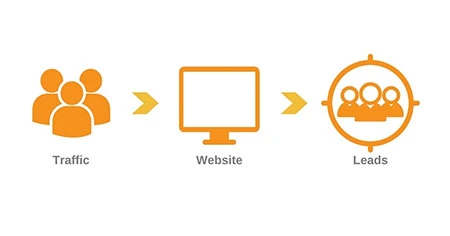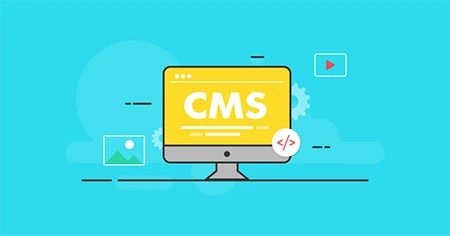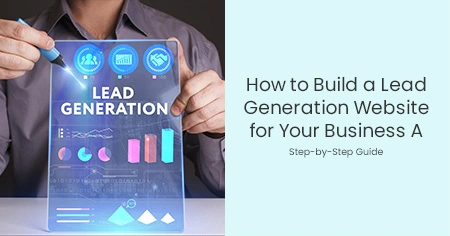A lead generation website can help your businesses identify new ways of marketing themselves and generate leads through social media or other forms of communication.
According to statistics, the number one challenge for 61% of marketers is generating leads.
On the other hand, lead-generation websites are intended to attract visitors who could turn into potential customers—or partners in the future. A lead generation website provides quick access to information, eliminating spending hours searching or reading lengthy documents.
In this blog post, we'll guide you in building a lead-generation site for your business so that you can reach out to more prospects with the right message.
What is a lead generation website?

A lead-generation website is an effective marketing tool to help businesses generate leads and sales. Businesses can attract more visitors and convert them into leads by creating a lead generation-optimized website.
A lead generation site aims to get visitors to take action, such as filling out a form or signing up for a newsletter.
Tips: Before you begin heavily relying on your lead forms and email campaigns, prioritize the quality of your collected email addresses. Implementing a bulk email verification process ensures you're working with valid and active emails, preventing wasted efforts and improving your sender reputation. Clean data translates to higher engagement and better conversion rates.
- Homepage
- About Page
- Contact Page
- Product/service page
- Blog page
- Legal page
- Testimonials page
The following are the essential features of a lead generation website:
- Regular blog content
- Lead generation
- Optin pop-up.
16 Steps for Creating a Lead-Generating Website

Lead generation websites are an effective way to generate leads and convert them into customers. They can be built in any niche and are relatively easy to set up.
Now that we've covered the essential components of a lead-generation website let's walk through the process of generating leads through your website.
Step 1: Start with a goal
Before you build your lead generation website, consider what your goal for it is. Your main goal, of course, is to generate leads but get more specific.
- What do you want people to do on your website?
- Do you want to educate the buyer about your product or industry?
Consider your lead generation goals to help you plan which elements to look for on your lead generation website.
Step 2: Find out what kind of website you want.

The second step is to find out what type of website you want and then select the best site for your business. Consider the type of website you want before deciding on the best niche. You can design and build multiple websites or hire someone to do it for you.
These include e-commerce websites, blogs, review sites, and other resources. The second step comes after determining which type of website is best for your business.
Marketing sites and blogs are ideal for businesses looking to establish a brand. Online retail stores are for those who sell their products online. Make sure you know which website you want to publish on. For example, a personal blog is the best option if you are a photographer.
Step 3: Research your competition.
The third step in designing a website is to research your competitors. Research the points:
- Who are they?
- What are their strengths and weaknesses?
- How do they compare to you?
Once you've done this research, it'll be easier to determine who your target audience is and what features your site should include.
When researching your competition for a lead generation website, keep a few key points in mind.
- First, consider their overall design and how user-friendly it is. Is it simple to navigate and find the information you are looking for? If not, this is something you can strive to improve.
- Second, consider their content strategy. What types of blog posts or other resources do they provide that may be useful to potential leads? Can you provide better-quality content?
- Finally, look at how they generate leads through social media. Are they active on platforms where your target audience spends their time? If so, what strategies do they employ that you could emulate?
By researching your competitors, you can learn much about what works (and what doesn't) for lead generation online.
Step 4: Define Your Target Audience
The fourth step in lead generation is to identify your target audience. Your target audience is the cornerstone of any successful marketing strategy. The more you know about them, the more effectively you can reach them via all channels.
This means understanding not only who your ideal customer is but also what they want and need from you.
Once you know this, you can start developing marketing materials and strategies tailored to them. Conduct market research to learn more about your target audience.
Let's start with the basics.
- Who are they?
- What are they interested in?
- How old are they?
- What gender do they identify as?
- What are their issues and challenges?
- Are they married, single, separated, or widowed?
- Do they have any children or pets?
- What motivates them to purchase?
- What is their occupation and income?
These questions can help you better understand your target audience.
Step 5: Find a CMS (content management system) tool.

When you create a lead generation website, you have one specific goal: to increase the number of leads for your company. This means you should look for a CMS that makes capturing and converting leads easier.
The best CMS tool for lead generation includes lead generation-specific optimizations. It should have sign-up and contact forms, live chat, email marketing features, and built-in analytics to track and measure your lead generation efforts. For example, integrating tools like an email tracker for Outlook can enhance your follow-up strategy by letting you know when potential leads open your emails, helping you respond at the right time.
"These features will make it easy to assemble a functional and attractive website without any website development or coding experience."
Step 6: Create a landing page
After you've set up your lead generation website, you can create your first landing page. Your CMS tool should make creating and optimizing a high-converting landing page simple. A few key elements your landing page must have are:
- Compelling headline.
- A strong CTA button.
- Bullet points that outline the key benefits.
- Product image
- A few sentences of copy
Step 7: Create a Niche Relevant Content
Content marketing is a practice that has gained popularity in recent years. It is promoting your content through all channels, such as print, digital, social media platforms, and any other source where your target audience may be looking for information. Content marketing aims to create engaging content that will capture your audience's attention and drive them to your product or service. Following that, you must create relevant and exciting content to hold visitors' attention.
On the other hand, a writing assistant is a more convenient and cost-effective way to create content for your website.
As you develop niche-relevant content for your blog or resource pages, consider offering valuable tools and tips tailored for specific platforms. For example, businesses using Snapchat can boost their content strategy with scheduling solutions and analytics. Incorporating a snapchat reporting tool not only simplifies post scheduling but also provides deep insights into engagement metrics, helping refine your social media approach and optimize lead generation from audiences active on Snapchat.
These artificial intelligence-powered writing assistants can create content for your landing pages, social media posts, email newsletters, blogs, and more. Bloggers are using these tools to save time and energy while focusing solely on the creative content of their work.
Step 8: Keep the website design responsive and simple.

A well-designed website is vital for the success of any business in today's world. A poorly designed or difficult-to-navigate site will quickly lose potential visitors.
The most important thing is to keep your website simple and clutter-free. You want people to quickly find the information they want without sifting through clutter and distractions.
Step 9: Include a strong CTA
When creating a lead generation website, it is critical to include a strong CTA. This will encourage visitors to take the next step and provide contact information.
Your CTA should be clear, concise, and stand out from the rest of the page. It should also be placed in a prominent location so visitors do not overlook it.
Ensure that your CTA is relevant to your offer. For example, if you offer a free eBook, your CTA could read "Download Now." If you want to increase conversions on your lead generation website, include a solid call to action!
Step 10: Optimize Your Website for SEO
Search engine optimization (SEO) helps your website rank higher in search engine results pages (SERPs). Businesses often turn to white label SEO solutions to efficiently scale their optimization efforts without compromising quality. By optimizing your website for SEO, you increase the likelihood that your target audience will find it while searching for relevant keywords and phrases.
Many factors influence SEO, including keyword research, on-page optimization, and link building. You can boost organic traffic to your website by researching keywords and optimizing its content and meta tags.
Step 11: Create a sitemap
Creating a sitemap is a critical step in designing your website. A sitemap is a document that provides an overview of the website and its pages, such as titles, descriptions, and layouts.
It helps you visualize how the site will look when finished. Creating a sitemap can help you understand how visitors navigate your website and what they see on each page.
For example, if you're designing a clothing shopping website, your homepage may include links to various clothing sections (dresses, pants).
This page could also contain information about sizing or seasonal trends. When users click on one of these links, they are directed to another page to browse these types of clothes in greater detail.
Step 12: Use an A/B Testing Tool.
An A/B testing tool can help you improve your website's design and lead generation abilities. Running tests on different versions of your website will allow you to determine which one performs better regarding conversion rate or other key metrics. This will allow you to make the changes required to improve the overall performance of your website.
Step 13: Use attractive visuals
Using attractive visuals on your site can help you generate more leads. A well-designed site will entice visitors to stay and explore more of your offerings. Designers should use eye-catching visuals when creating lead-generation websites to entice and keep users on the site. Good design can help you keep potential customers engaged with your content.
Step 14: Add Lead Magnets

Using lead magnets to attract and retain leads is critical when creating a lead generation website. Lead magnets are content or offers intended to entice visitors to join your email list or contact you for additional information. Here are some common lead magnet ideas:
- eBooks
- Guides
- white papers
- Templates
- Checklists
- Assessment
- toolkits
You can also provide free trials, coupons, or priority access to content or services. Whatever you choose, make sure it appeals to your target audience and gives them a reason to sign up.
Step 15: Utilize social media and email marketing.
Social media and email marketing effectively promote content and generate leads. By sharing your content on email and social media with a larger audience, you can encourage them to visit your site.
Selecting the platforms most relevant to your intended audience is critical when using social media. For example, if you're targeting millennials, you might want to focus on Instagram and Snapchat, while if you're targeting business professionals, you might want to focus on or extract emails from LinkedIn. When using email marketing software, segment your audience and personalize your messages. By sending targeted messages to specific segments of your audience, you can improve the relevance and effectiveness of your campaigns.
Step 16: Analyze and Improve Your Lead Generation Strategy

Finally, it is important to analyze and improve your lead generation strategy. Analytics tools can help you monitor your website's performance and identify improvement areas. Experiment with offers, CTAs, and landing pages to see what works best for your target audience.
You can generate more leads and expand your business by constantly analyzing and improving your lead generation strategy.
Conclusion
MaA lead generation website is a site that is used to generate leads for your business. It should include a landing page, email capture form, and lead capture form, all required for lead generation. Creating leads with your website is critical to any successful online marketing strategy.








